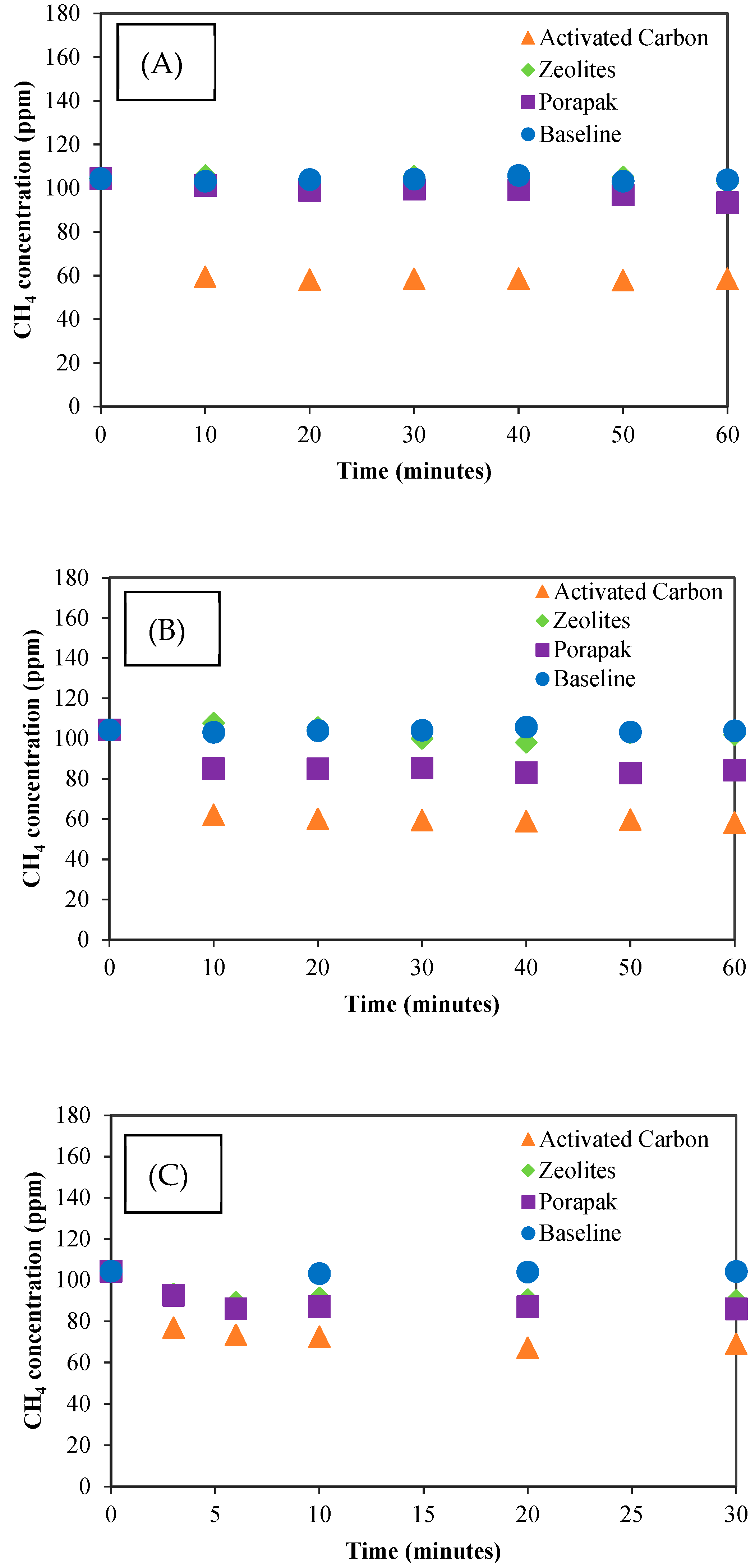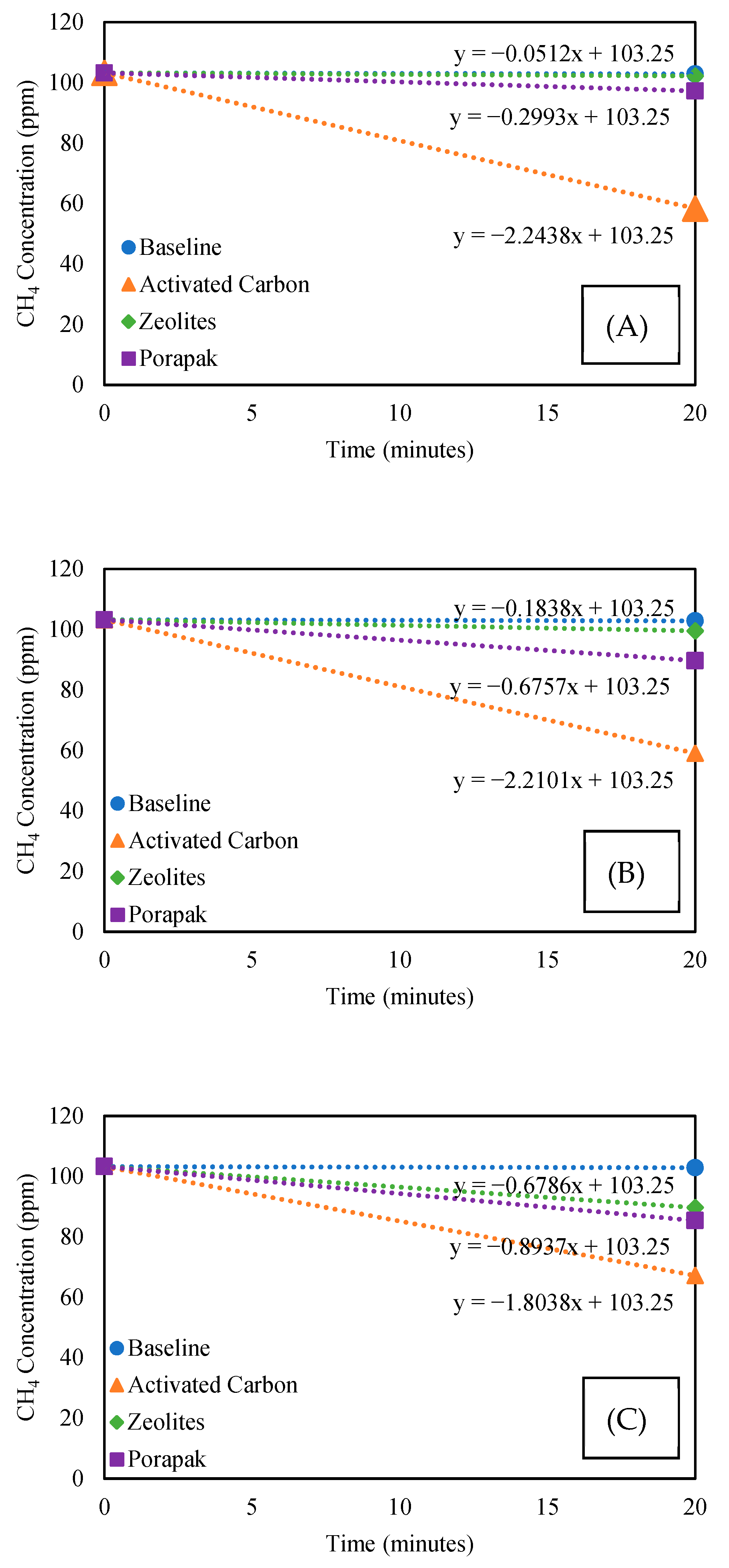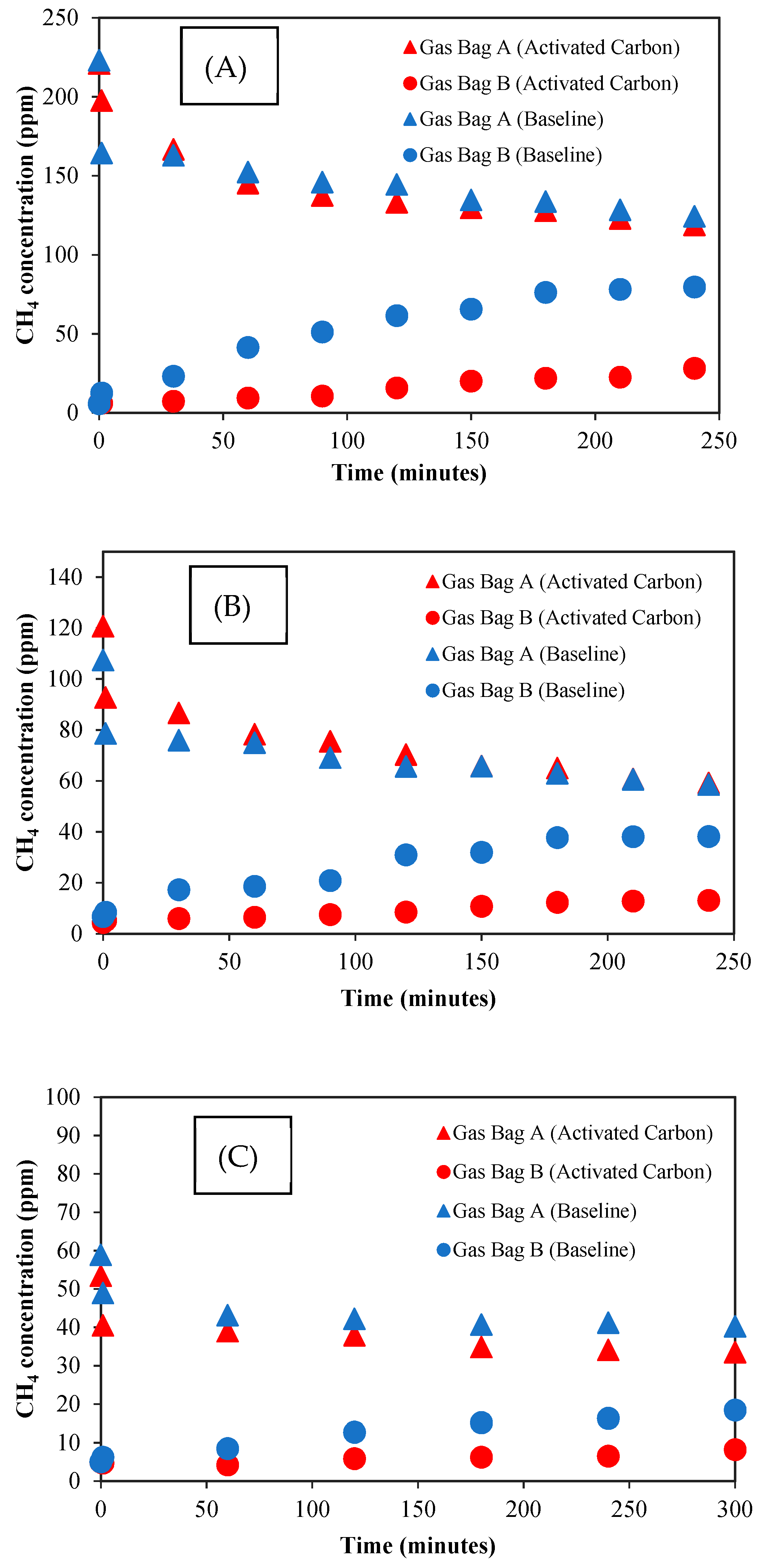The Development of a Low-Cost Method for Monitoring Methane Leakage from the Subsurface of Natural Gas Fields
Abstract
:1. Introduction
2. Results
2.1. Screening Adsorbents
2.2. Column Diffusion
3. Discussion
3.1. Thermal Desorption
3.2. Low-Cost Method for Monitoring Methane Leakage
4. Materials and Methods
4.1. Adsorbents
4.2. Screening Adsorbents
4.3. Column Diffusion
4.4. Thermal Desorption
4.5. Proposed Method
5. Conclusions
Author Contributions
Funding
Institutional Review Board Statement
Informed Consent Statement
Conflicts of Interest
References
- Intergovernmental Panel on Climate Change (IPCC). Mitigation of Climate Change: Energy Systems; Fifth Assessment, Report; IPCC: Cambridge, UK; Cambridge University Press: Cambridge, UK, 2014. [Google Scholar]
- European Environment Agency (EEA). EEA air pollutant emission inventory guidebook-2009. In Technical Guidance to Prepare National Emission Inventories; EEA Technical Report No 6/2009; EEA: Copenhagen, Denmark, 2009. [Google Scholar]
- Maasakkers, J.D.; Jacob, D.J.; Sulprizio, M.P. Global distribution of methane emissions, emission trends, and OH concentrations and trends inferred from an inversion of GOSAT satellite data for 2010–2015. Atmos. Chem. Phys. 2019, 19, 7859–7881. [Google Scholar] [CrossRef] [Green Version]
- Le Mer, J.; Roger, P. Production, oxidation, emission, and consumption of methane by soils: A review. Eur. J. Soil Biol. 2001, 37, 25–50. [Google Scholar] [CrossRef]
- Klusman, R.W.; Jakel, M.E. Natural microseepage of methane to the atmosphere from the Denver-Julesburg basin, Colorado. J. Geophys. Res. Atmos. 1998, 103, 28041–28045. [Google Scholar] [CrossRef]
- Mosier, A.R.; Schimel, D.S. Influence of agricultural nitrogen on atmospheric methane and nitrous oxide. Chem. Ind. 1991, 23, 874–877. [Google Scholar]
- Sechman, H.; Kotarba, M.J.; Fiszer, J.; Dzieniewicz, M. Distribution of methane and carbon dioxide concentrations in the near-surface zone and their genetic characterization at the abandoned “Nowa Ruda” coal mine (lower Silesian Coal Basin, SW Poland). Int. J. Coal Geol. 2013, 116, 1–16. [Google Scholar] [CrossRef]
- Tang, J.; Xu, Y.; Wang, G.; Etiope, G.; Han, W.; Yao, Z.; Huang, J. Microseepage of methane to the atmosphere from the Dawanqi oil-gas field, Tarim Basin, China. J. Geophys. Res. Atm. 2017, 122, 4353–4363. [Google Scholar] [CrossRef]
- Riddick, S.N.; Denise, L.; Mauzerall, M.A.; Celia, M.K.; Bressler, K.; Chu, C.; Gum, C.D. Measuring methane emissions from abandoned and active oil and gas wells in West Virginia. Sci. Total Environ. 2019, 651, 1849–1856. [Google Scholar] [CrossRef] [PubMed]
- Sechman, H.; Kotarba, M.J.; Kedzior, S.; Dzieniewicz, M.; Romanowski, T.; Twaróg, A. Distribution of methane and carbon dioxide concentrations in the near-surface zone, genetic implications, and evaluation of gas flux around abandoned shafts in the Jastrzębie-Pszczyna area. Int. J. Coal Geol. 2019, 204, 51–69. [Google Scholar] [CrossRef]
- Xu, L.; Vath, R.; McCoy, J. Chamber-Based Soil Methane Flux Measurement; LI-COR Biosciences: Lincoln, NE, USA, 2018. [Google Scholar]
- Fredenslund, A.M.; Scheutz, C.; Kjeldsen, P. Tracer method to measure landfill gas emissions from leachate collection systems. Waste Manag. 2010, 30, 2146–2152. [Google Scholar] [CrossRef] [PubMed]
- Dantas, T.L.P.; Luna, F.M.T.; Silva, I.J., Jr.; Torres, A.E.B.; de Azevedo, D.C.S.; Rodrigues, A.E.; Moreira, R.F.P.M. Modelling of the fixed-bed adsorption of carbon dioxide and a carbon dioxide-nitrogen mixture on zeolite 13X. Braz. J. Chem. Eng. 2011, 28, 533–544. [Google Scholar] [CrossRef]
- Belmabkhout, Y.; Sayari, A. Adsorption of CO2 from dry gases on MCM-41 silica at ambient temperature and high pressure. 2: Adsorption of CO2/N2, CO2/CH4 and CO2/H2 binary mixtures. Chem. Eng. Sci. 2009, 64, 3729–3735. [Google Scholar] [CrossRef]
- Rios, R.B.; Silva, F.W.M.; Torres, A.E.B.; Azevedo, D.C.; Cavalcante, C.L. Adsorption of methane in activated carbons obtained from coconut shells using H3PO4 chemical activation. Adsorption 2009, 15, 271–277. [Google Scholar] [CrossRef]
- Abdeen, Z.; Somaia; Mohammad, G. Study of the Adsorption Efficiency of an Eco-Friendly Carbohydrate Polymer for Contaminated Aqueous Solution by Organophosphorus Pesticide. J. Org. Polym. Mater. 2014, 4, 16–28. [Google Scholar] [CrossRef] [Green Version]
- Ion, V.A.; Parvulescu, O.C.; Dobre, T.; Duteanu, N.; Nitu, S.G. Modelling of Thermal Desorption of Volatile Organic Compounds from Activated Carbon. Rev. De Chim. 2015, 66, 703–706. [Google Scholar]












| Adsorbent | Amount of Adsorbed CH4 (10−3 mg/g Adsorbent) | ||
|---|---|---|---|
| 5 g | 10 g | 15 g | |
| Activated carbon | 1.187 | 0.585 | 0.317 |
| Zeolites | 0.017 | 0.044 | 0.117 |
| Porapak | 0.150 | 0.175 | 0.155 |
| Initial Concentration (ppm) | Final Concentration (ppm) | Adsorbed CH4 Amount (10−3 mg/g-AC) | |
|---|---|---|---|
| Without AC | With AC | ||
| 200 | 79.7 | 28.2 | 0.818 |
| 100 | 38.2 | 13.2 | 0397 |
| 50 | 18.4 | 8.24 | 0.161 |
Publisher’s Note: MDPI stays neutral with regard to jurisdictional claims in published maps and institutional affiliations. |
© 2021 by the authors. Licensee MDPI, Basel, Switzerland. This article is an open access article distributed under the terms and conditions of the Creative Commons Attribution (CC BY) license (https://creativecommons.org/licenses/by/4.0/).
Share and Cite
Farhan, M.A.; Sugai, Y.; Widodo, N.P.; Syafrizal, S. The Development of a Low-Cost Method for Monitoring Methane Leakage from the Subsurface of Natural Gas Fields. Methane 2022, 1, 24-37. https://doi.org/10.3390/methane1010003
Farhan MA, Sugai Y, Widodo NP, Syafrizal S. The Development of a Low-Cost Method for Monitoring Methane Leakage from the Subsurface of Natural Gas Fields. Methane. 2022; 1(1):24-37. https://doi.org/10.3390/methane1010003
Chicago/Turabian StyleFarhan, Muhammad Alfiza, Yuichi Sugai, Nuhindro Priagung Widodo, and Syafrizal Syafrizal. 2022. "The Development of a Low-Cost Method for Monitoring Methane Leakage from the Subsurface of Natural Gas Fields" Methane 1, no. 1: 24-37. https://doi.org/10.3390/methane1010003
APA StyleFarhan, M. A., Sugai, Y., Widodo, N. P., & Syafrizal, S. (2022). The Development of a Low-Cost Method for Monitoring Methane Leakage from the Subsurface of Natural Gas Fields. Methane, 1(1), 24-37. https://doi.org/10.3390/methane1010003







